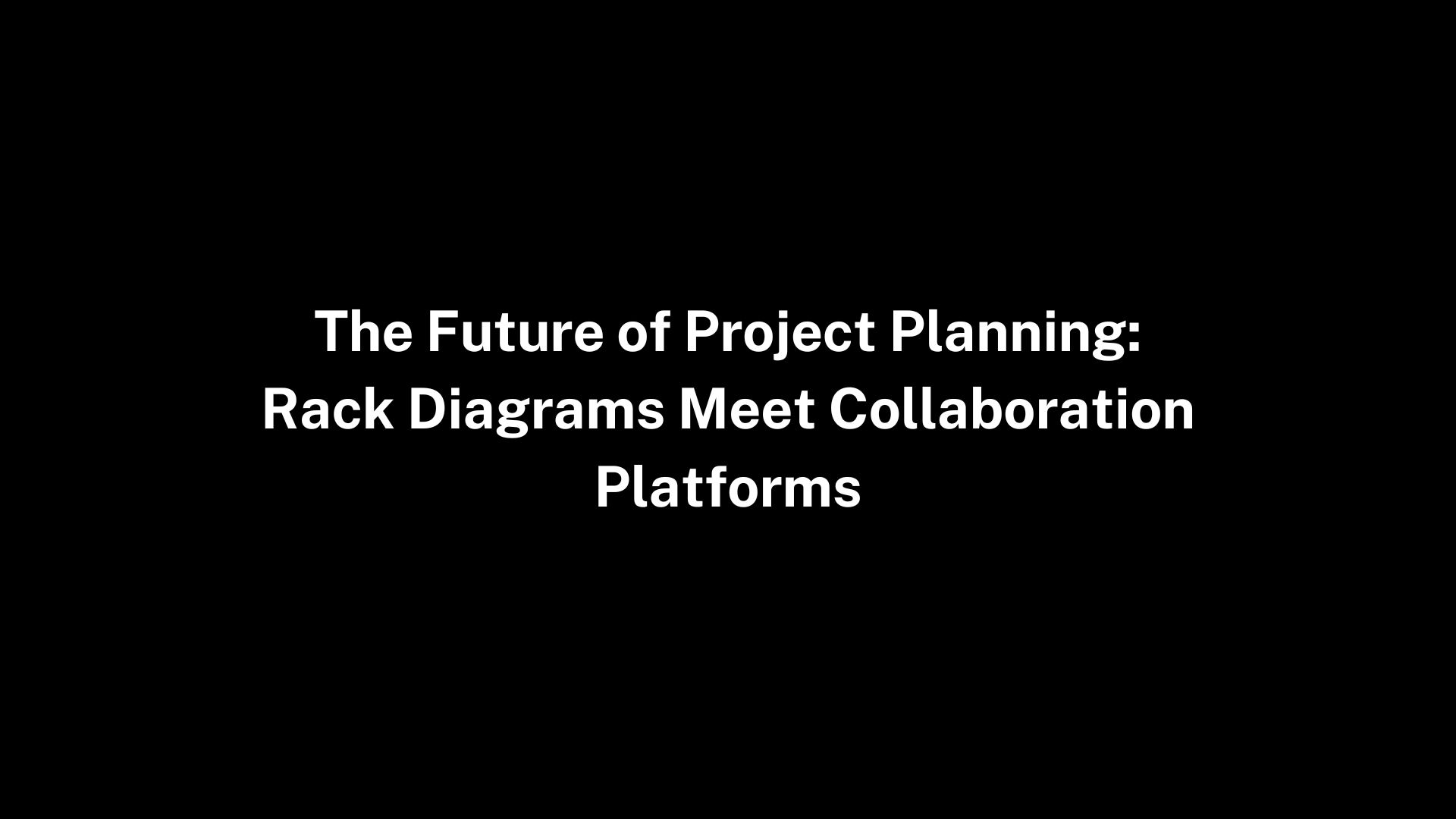Project planning is undergoing a massive shift. In today’s fast-paced, interconnected world, teams no longer rely on static documents or disjointed tools to manage complex AV and IT installations. The modern approach? A fusion of visual design and collaborative execution. This transformation is especially evident in the rise of rack diagram software that integrates directly with collaboration platforms.
As AV and IT projects grow more complex—with hybrid workspaces, cloud-based systems, and real-time monitoring needs—the need for a centralized, visual, and collaborative planning environment is no longer optional. It’s the future of project planning.
In this blog, we’ll explore how rack diagrams are evolving from static visuals to dynamic, shareable assets, how integration with project management tools enhances team productivity, and which platforms are leading the charge in this space.
Why Rack Diagrams Are Central to AV and IT Projects
Rack diagrams are more than just technical blueprints—they’re the foundation of physical infrastructure planning. They show how devices like servers, switches, DSPs, amplifiers, and control systems are arranged, powered, and connected within AV and IT environments.
AV integrators and IT professionals rely on rack diagram software to:
-
Plan space utilization in equipment rooms
-
Prevent overheating or power overload
-
Ensure compliance with best practices for cabling and connectivity
-
Coordinate rack layouts across multi-site installations
-
Document systems for future servicing
But traditionally, rack diagrams lived in PDFs or on desktop software—siloed from the broader workflow. That’s changing.
The Shift: From Static Diagrams to Collaborative Planning Hubs
1. Real-Time Updates for Real-World Agility
In the old model, when a change was made to the rack—say a switch model was swapped—it would require back-and-forth emails and manual updates to the diagram. Now, cloud-based rack diagram software allows real-time updates that reflect instantly across teams.
2. Multi-Team Access for Cross-Functional Workflows
AV, IT, project managers, and field techs all need different levels of access to the same information. Integrated platforms allow:
-
AV teams to design the layout
-
IT teams to confirm network provisioning
-
Project managers to track dependencies and task status
-
Field techs to install accurately using mobile-friendly views
3. Linking Design to Task Management
When rack diagram software syncs with tools like Trello, Asana, ClickUp, or Monday.com, teams can attach tasks to individual components. For example:
-
“Install 48-port PoE switch – Rack 4, U10–U11”
-
“Cable test for audio DSP – Rack 2, U20”
This level of diagram-to-action visibility drastically reduces miscommunication.
Read more: https://mohamedsalahclub.com/read-blog/10456
Benefits of Integrating Rack Diagram Software with Collaboration Platforms
1. Single Source of Truth
Everyone—designers, engineers, PMs, and installers—works from the same data, reducing version control issues.
2. Improved Accountability
With tasks tied to diagram components, it’s easy to assign ownership, deadlines, and checklists.
3. Faster Turnarounds
Instant notifications on changes, status updates, or bottlenecks keep the project moving forward.
4. Remote Access
With cloud-based integration, teams in the field or in different offices can access the latest rack diagram anytime, anywhere.
5. Audit and Compliance Ready
Track every change, see who did what, and create a project record that simplifies future upgrades or inspections.
Use Case: Planning an AV System Across Multiple Office Locations
A national AV integrator needs to deploy standardized AV racks in 10 regional offices. By using rack diagram software connected with a project management tool:
-
The AV design team creates rack layouts using drag-and-drop templates
-
IT validates equipment compatibility and assigns IPs
-
PMs create timelines and assign installation tasks per location
-
Field techs access diagrams on-site and upload post-install photos
-
QA teams verify installations using rack-linked checklists
All of this happens in a shared, cloud-based environment—eliminating confusion and compressing timelines.
Key Features to Look for in Rack Diagram Software for Collaboration
| Feature | Why It Matters |
|---|---|
| Cloud-Based Access | Enables remote collaboration and real-time updates |
| Task Integration | Links components to project actions |
| Multi-User Roles | Gives control over who can edit, view, or comment |
| Revision History | Tracks changes across the project lifecycle |
| Export Options | Supports PDF, CAD, or BIM workflows |
| Visual Alerts | Flags conflicts (e.g., overheating, power draw) within the diagram |
| Mobile Optimization | On-site teams can view and interact from tablets or phones |
Leading Platforms Merging Rack Diagrams and Collaboration
1. XTEN-AV
-
What it does: AI-powered rack diagram creation and system design
-
Collaboration: Assign tasks, share diagrams live, track project status
-
Why it stands out: Integrates AI design with end-to-end project workflow
2. Lucidchart
-
What it does: General-purpose diagramming with AV and IT templates
-
Collaboration: Excellent live editing and integrations with Slack, Asana, and more
3. Draw.io (now diagrams.net)
-
What it does: Free rack layout capabilities with GSuite integration
-
Collaboration: Best for small teams that use Google Workspace
4. NetZoom or Visio with SharePoint
-
What it does: Deep IT asset modeling
-
Collaboration: More enterprise-focused, requires setup
The Future: AI and Automation Within Rack Diagrams
Looking ahead, the next evolution of rack diagram tools will include:
-
AI Auto-Layout: Suggesting rack placements based on space, heat, and connectivity
-
Predictive Alerts: Detecting potential conflicts (e.g., power load issues) before deployment
-
Voice Commands: “Add DSP to Rack 2, below amplifier”
-
Auto-Linked Procurement: Connect diagrams directly to bill of materials and vendors
These features will not only streamline planning—but tie rack diagrams directly to project execution, purchasing, and analytics.
Conclusion
As AV and IT systems continue to converge, the tools we use to plan them must evolve too. The combination of rack diagram software and collaboration platforms represents a major leap forward—bringing clarity, speed, and synergy to complex technology projects.
No longer just static visuals, rack diagrams are now living documents that drive decision-making, track progress, and unify teams. The future of project planning isn’t in isolated tools—but in integrated ecosystems where diagrams, tasks, and people work together seamlessly.
